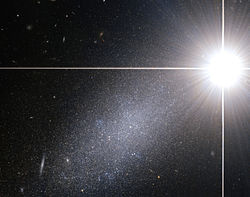| PGC 39058 | |
|---|---|
 PGC 39058 imaged by the Hubble Space Telescope | |
| Observation data (J2000 epoch) | |
| Constellation | Draco |
| Right ascension | 12h 14m 08.4s [1] |
| Declination | +66° 05′ 41″ [1] |
| Redshift | 0.000227 [1] |
| Heliocentric radial velocity | 68 [1] |
| Distance | 17.710 ± 0.055 Mly (5.430 ± 0.017 Mpc) [1] |
| Apparent magnitude (V) | 14.6 [1] |
| Characteristics | |
| Type | Scd |
| Apparent size (V) | 1.95' x 0.8385' [1] |
| Other designations | |
| UGC 7242, PGC 39058, MCG+11-15-037 [2] | |
PGC 39058 is a dwarf galaxy located 17.7 million light-years away in the constellation Draco. The galaxy is faint and obscured by HD 106381, a star in the foreground making it difficult to observe. [3]